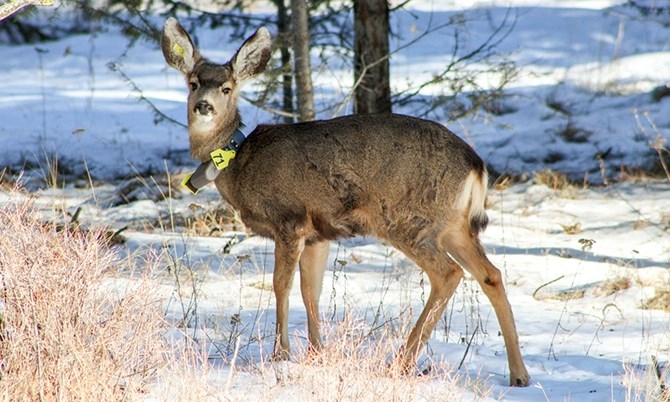
A UBC Okanagan study is looking at reasons for the decline in mule deer populations in the province.
Image Credit: SUBMITTED / UBC Okanagan
February 02, 2020 - 6:00 AM
An Okanagan wildlife researcher has been closely watching blinking dots merge on his tracking device, like a video game, only the dots represent actual cougars and mule deer.
Adam Ford is an assistant professor and Canada research chair at the Wildlife Restoration Ecology Lab at UBC Okanagan. He, along with UBCO PhD student Chloe Wright who joined the lab last fall, are investigators in the largest collaborative mule deer study in the province’s history. Ford is also tracking the movements of cougars in the Okanagan area, to learn more about the species.
While he said it’s difficult to say whether there’s been an increase of predators in the valley and what role they play with mule deer populations, there’s less of a stigma around them.
“There’s a broader trend across western North America about predators coming back. There’s less poisoning of the animals, so (they’ve returned) to the landscape,” he said.
A cougar sighting in early January prompted the District of Lake Country to issue a warning to the Carr’s Landing neighbourhood.
“I think people recognize species... have a place on the landscape whereas 50 years ago, 100 years ago, they would remove them,” Ford said.
Roughly 100 mule deer are wearing tracking collars as part of the Southern Interior Mule Deer Project, an ongoing study to understand the drastic decline in mule deer populations. Last year, Ford began to track cougars and has collared eight so far in the Okanagan and three in the Koocanusa area in the Kootenays.
“One of the points in the study is to get those collared cougars in the same areas as mule deer are to see how they’re interacting with one another and I think that’s going to be a really cool dataset to look at,” he said.
“We know cougars are the main predator for the mule deer and we have to figure out why. It kind of varies by area, in the Boundary Country (the region between the Okanagan and Kootenays) a lot more mule deer die from cougars than in the west Okanagan and we don’t know if there are more cougars, or is it the habitat that makes it easier for the cougars to get the deer,” he asked.
One theory, supported by anecdotal evidence, is that cougars are an ambush hunter and they will do well in habitats that have cover or rocky topography to hide before they pounce on their prey, Ford said.
After the 2003 wildfires in Kelowna, Ford said mule deer populations increased but no one saw cougars in that area. Now as the area has become infilled with brush and shrubs, it makes a great habitat for cougars to hide.
Mule deer like having good vantage points so they can watch for predators, Ford said, so the brush becomes a better habitat for whitetail deer.
“Systems could be shifting in these post burn areas to become less mule deer friendly,” he said. “It remains to be seen what’s happening in these different study areas, but that’s what we aim to find out, to go back to those places like the Mount Eneas fire (near Peachland) and see if mule deer are doing better in those areas.”
The study’s aim is to better understand a drastic decline in B.C.’s mule deer population in the last 50 years.
"Mule deer are considered an indicator species and their population health is tied to what is going on in the rest of the landscape” UBCO PhD student Chloe Wright said. “The more nutritious the ecosystem, the healthier deer.”
The study uses GPS collars to gather data on deer in three different regions including Grand Forks, Garnet Valley, Summerland and Ashcroft.
She said when fires rip through a forest it’s a common thought to think there is nothing left.
“Actually, it turns out that the plants that grow in the first couple of years after a fire are really nutritious and there’s a lot more of them. It’s possible these wildfires might actually be really good fo mule deer,” she said.
Wright uses a clover trapping method that enables the team to subdue deer with nets, not tranquilizers. They are able to take samples and use ultrasound machines to check for pregnancy, count the number of fetuses and determine the body condition of a deer.
She said urbanizations has played a large role in presenting barriers to migration patterns deer have followed for generations.
Mule deer have an ability to remember migration routes hundreds of kilometres long, but if a fence suddenly intersects a migration path, the deer don’t have the plasticity of mind to find new routes, Wright said.
“There’s been a number of changes on the landscape, and we’re just trying to figure out which of these things is driving mule deer populations the most. Then hopefully we can provide management recommendations for things that wildlife managers can change to bring mule deer populations back to where they used to be,” Wright said.
The next phase of the project will be to place 50 cameras in each of the three study areas to add to the understanding of what is causing the decline in mule deer.
Wright said the cameras will help give researchers an idea of predator density and how many other species mule deer may be competing with.
The Southern Interior Mule Deer project is expected to continue until 2022. Study partners include the UBC Okanagan, Okanagan Nation Alliance, BC Wildlife Federation, the Habitat Conservation Trust Foundation, the University of Idaho and the BC Fish and Wildlife Branch.
— With files from Steve Arstad
News from © iNFOnews, 2020